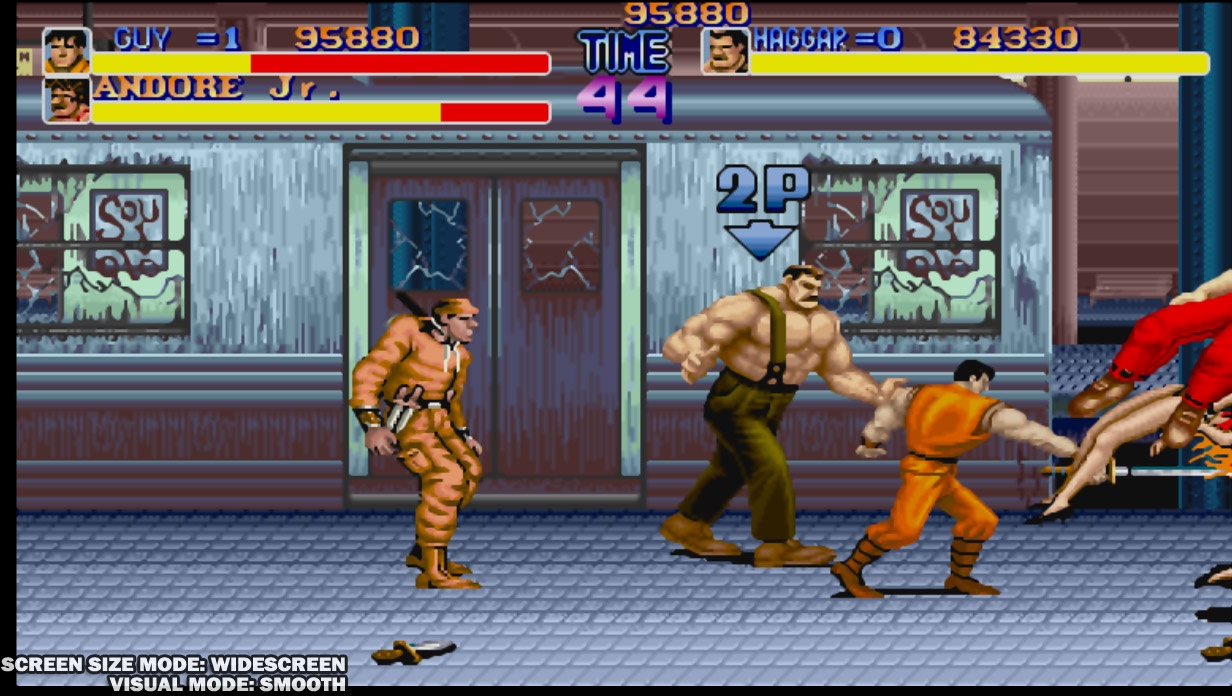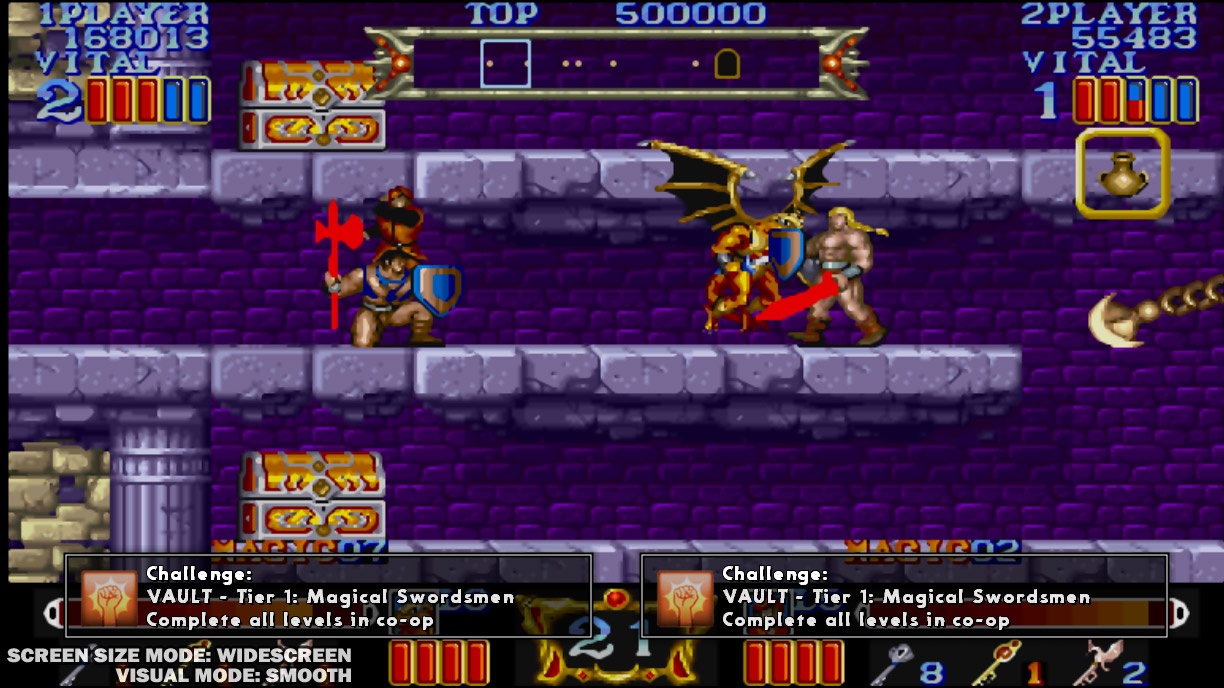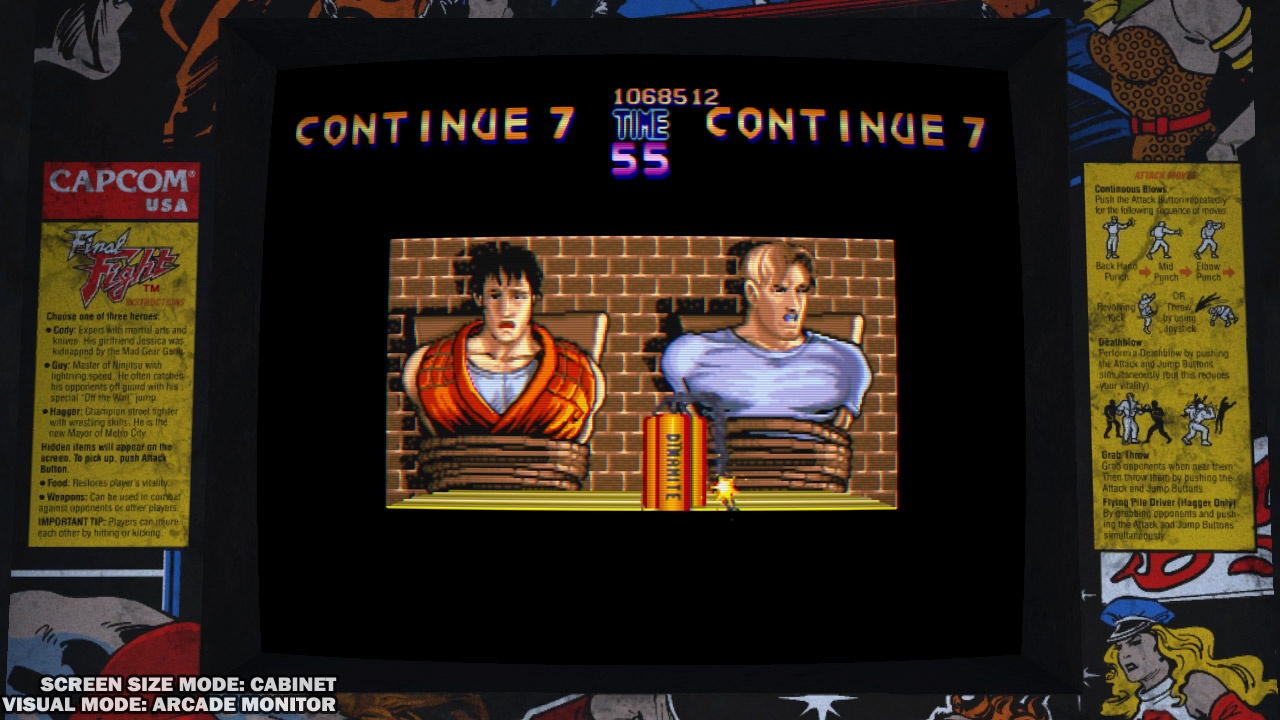Resurrecting arcade games from the '80s and '90s is a tricky thing. You need to choose carefully because so many games from the past may evoke fond memories, but they just don't hold up well today. Thankfully, with Final Fight: Double Impact, Capcom and Proper Games have brought back two deserving and enjoyable gems from yesteryear: Final Fight and Magic Sword. They've also presented them in an authentic way that will particularly delight fans who are old enough to have fed quarters into them. At the same time, they've taken a cue from current games, offering a rather robust series of challenges for both games. All of this makes Double Impact a very solid pair of games. It's also a good example of how older games can be presented in a way that feels contemporary, yet true to their arcade origins.

Final Fight is the headliner here and rightfully so. Arcades were once flooded with beat-'em-ups, but Final Fight always stood out from the crowd, thanks to its great playable characters, strong visual design, and immensely satisfying gameplay. And as Double Impact demonstrates, it's still a lot of fun today. The premise is as old as time: A vile gang called the Mad Gears kidnaps Metro City mayor Mike Haggar's daughter in an attempt to strong-arm him into letting their crime wave continue. Apparently, they don't know that Mike Haggar has stronger arms than any other US mayor. Before setting off to introduce the Mad Gears to his massive fists, Haggar recruits Jessica's boyfriend, Cody, and Cody's friend Guy. They are martial artists who are also ready and willing to walk from left to right through a series of stages, unleashing a world of hurt on Mad Gear thugs all the while.
Dishing out pain to Mad Gears is enjoyable because your attacks feel powerful and nicely varied, despite having only a jump button and an attack button. In addition to standard attack combos, Cody and Guy can pull off jump kicks, throws, and special moves that are effective when you're surrounded, but they cost some health to use. No graceful martial artist, the barrel-chested Haggar employs some awesome wrestling moves, including a spinning lariat, a suplex, and an outrageous flying pile driver. The Mad Gears are a diverse bunch, too, with run-of-the-mill thugs, knife-throwing goons, heavyset men with a penchant for charging like bulls, somersaulting girls, squads of dynamite tossers, a masked swordsman, a corrupt cop, and many others. The variety of Mad Gears to clobber (and be clobbered by) keeps the action engaging, as does the scenery. Your trek through the seamy underbelly of Metro City begins in the slums then takes you on a subway ride through bars, back alleys, and a seaside park, as well as an uptown penthouse. While it's over in under an hour, it's a journey that stands up to multiple play-throughs and a game that clearly represents some of the best the genre has to offer.
It would be easy to write off the lesser-known Magic Sword as an also-ran in this collection, but it would be a mistake. It's a good arcade game in its own right, and the fact that it's very different from Final Fight in both setting and gameplay lends the overall package more variety. In Magic Sword, you play as a nameless hero, fighting his way to the top of the evil Drokmar's tower. The action is much faster here, with the screen frequently filling with all manner of fantasy creatures, most of which succumb to one quick swing from your sword. Unlike Final Fight, there are no degrees of foreground and background. You just run left or right, jumping and hacking away at the monsters in your path, and go through doors that take you up to the next level of the tower. Although each level is quite short, at 50 levels in all, the trek to the tower's top still feels substantial.

Magic Sword has a few elements that give it a bit more complexity than your average side-scrolling arcade game. A meter constantly fills up when you're not attacking, and when it's full, your next swing fires a projectile that can destroy enemies from a short distance. There are also chests everywhere which contain items that boost your attack power, improve the range and power of your projectile, and so on. Most significantly, there are locked cells throughout each level, from which the voices of trapped prisoners cry out things like, "Remove me!" and "Get me escape!" Should you respond to a poor soul's awkwardly worded plea for mercy by opening the cage, he or she will fight alongside you. These companions take many forms, including ninjas, amazons, wizards, knights, and lizardmen. They also have varying attack styles and strengths. Because you can only have one companion and potential new companions are everywhere, you're constantly presented with a choice between hanging on to your current companion, leveling him or her up, or swapping him or her out for a new companion who might be of a lower level.
Both of these games are at their best when two players join forces, and Double Impact makes this very easy. You can play with a friend locally or online or set up a game that anyone can drop into at any time, which is not unlike playing on your own at an arcade where any passerby can pop in a quarter. Speaking of quarters, because you have an unlimited supply here, there's no challenge involved in completing either of these games, but Proper Games has wisely included a wide assortment of challenges for both games. This establishes goals beyond just finishing the games and enhances the replay value. Completing these challenges unlocks original concept art, comic books, fan art, and other goodies. But be warned: The episode of the Street Fighter cartoon you can unlock here is so awful that you may never be able to look at Ken, Ryu, Cody, Guy, and Haggar the same way again.
Despite clearly showing their age, the visuals in both games are quite pleasing. Final Fight's large sprites and moody urban environments are more impressive, but the amount of activity happening at times in Magic Sword, and the speed with which it happens, help make up for its relative lack of detail. There are a number of filters that can be applied to the visuals, including one that smoothes out the edges; for purists, there is one that approximates an arcade monitor with scan lines and a phosphor glow. You can even have the screen framed by the original cabinet artwork, which is a detail that really enhances the evocation of an authentic arcade experience. Both games also offer either their original soundtracks or remastered versions. The updated soundtracks add some oomph but lose some of the charm of the originals. In both cases, it's nice to have a choice. The Xbox 360 and PlayStation 3 versions are largely identical, but annoyingly, the PS3 version requires you to be connected to the PlayStation Network at all times.

The biggest complaint that can be leveled at Double Impact is that these games show their age, both in terms of their visuals and their old-fashioned gameplay mechanics. But while there's no denying that the heyday of the side-scrolling arcade game has come and gone, Final Fight and Magic Sword are more than just museum pieces. The level of craft that went into the making of these games has stood the test of time and makes them enjoyable today. This collection may hold special appeal for those who experienced these games in the arcades of the past, but Double Impact's presentation and challenge system make it a great way for newcomers to learn all about street-fighter-turned-mayor Mike Haggar too. And that is a very good thing.